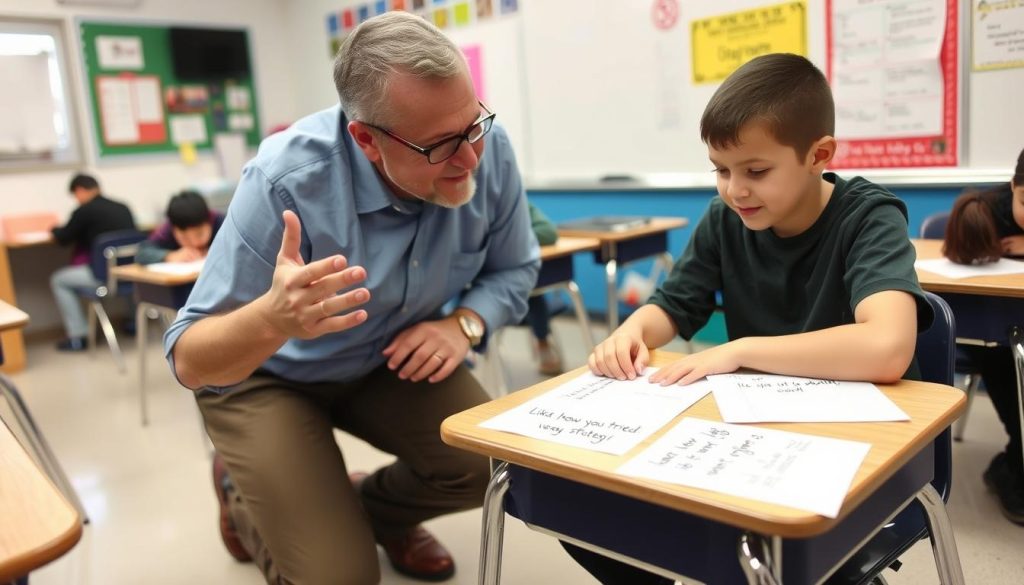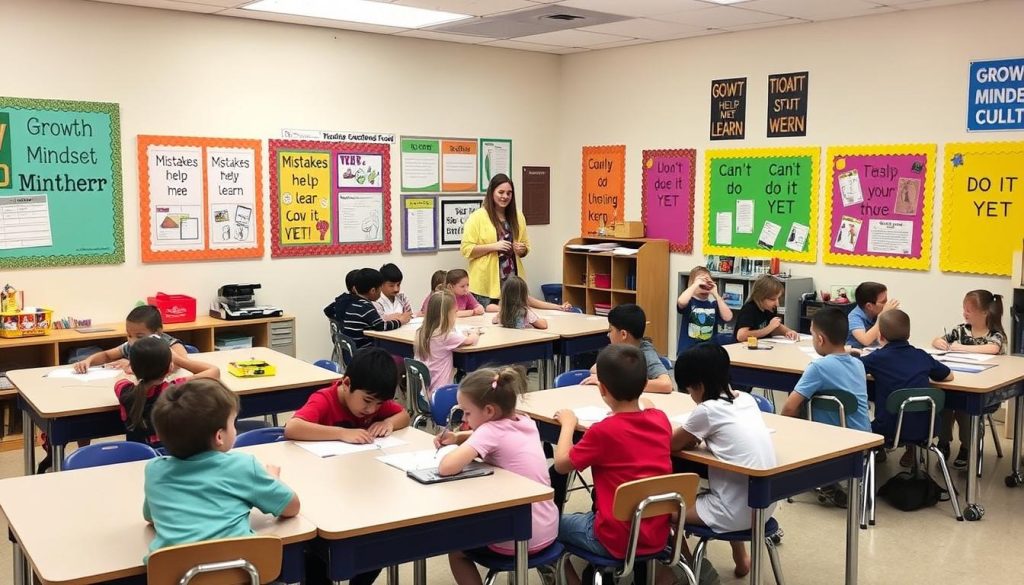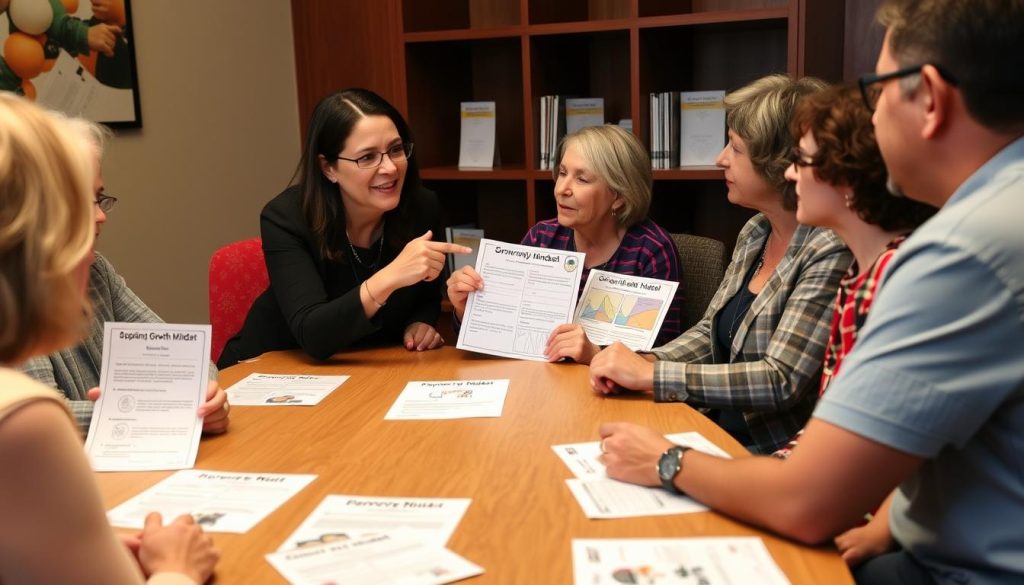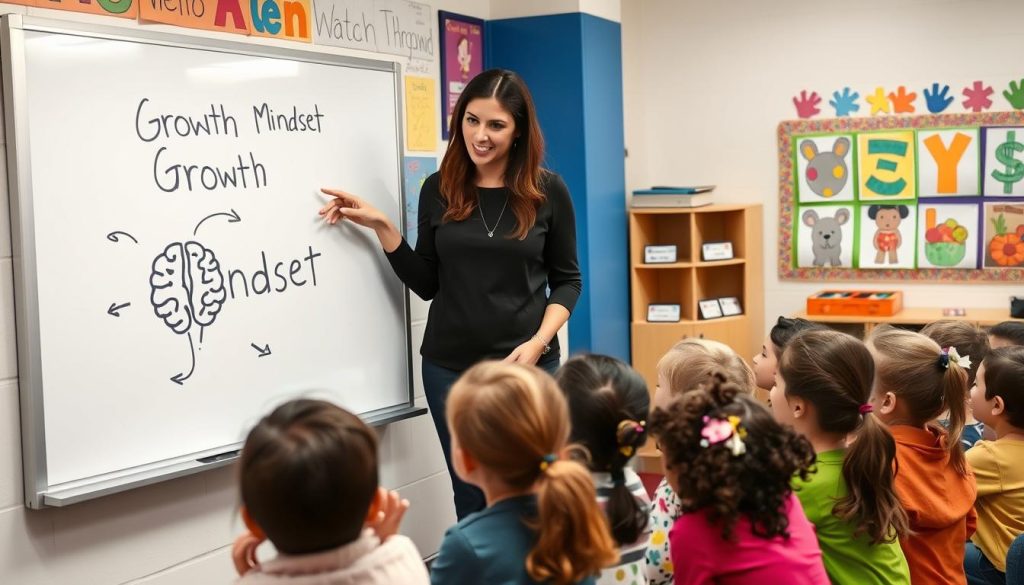Understanding Growth Mindset: Foundation for the 6 Steps for Teachers
Before diving into the 6 steps for teachers, it’s important to understand what a growth mindset truly means. Coined by Stanford psychologist Carol Dweck, a growth mindset is the belief that abilities can be developed through dedication and hard work. This view creates a love of learning and resilience essential for accomplishment.
In contrast, a fixed mindset assumes that intelligence and talent are static traits. Teachers with fixed mindsets may inadvertently limit student potential by focusing on innate ability rather than effort and process.
Research from Mindset Works shows that when teachers develop growth mindset-oriented teacher skills, student achievement increases significantly. These findings highlight why mastering the 6 steps for teachers to implement growth mindset principles is so crucial.
Key Insight: Teachers who develop their own growth mindset first are better equipped to foster it in their students. The 6 steps for teachers begin with personal mindset transformation.
Step 1 of the 6 Steps for Teachers: Examine Your Own Mindset

The journey of implementing the 6 steps for teachers begins with self-reflection. Before you can effectively teach growth mindset principles, you must identify your own mindset patterns. Do you embrace challenges as learning opportunities? How do you respond to setbacks in your teaching practice?
Developing these reflective teacher skills requires honesty about your reactions to professional challenges. Consider keeping a mindset journal to track your thoughts when facing difficult classroom situations or receiving feedback from colleagues or administrators.
Practical Self-Assessment Activities:
- Complete a mindset self-assessment quiz to identify fixed mindset triggers
- Record your internal dialogue when lessons don’t go as planned
- Reflect on how you discuss student abilities in your professional conversations
- Identify areas where you might be avoiding challenges due to fear of failure
Teachers who excel at this first step of the 6 steps for teachers create a foundation for authentic growth mindset instruction. Your students will notice the alignment between what you teach and how you personally approach challenges.
Looking for structured ways to assess your mindset? Credits for Teachers offers professional development resources specifically designed to help educators evaluate and strengthen their growth mindset orientation.
Step 2: Transform Your Language and Feedback Approach

The language teachers use profoundly impacts student mindset development. The second of the 6 steps for teachers focuses on transforming classroom communication to reinforce growth mindset principles. This requires developing specific teacher skills around feedback and praise.
Process praise (focusing on effort, strategies, and progress) rather than person praise (focusing on innate ability) has been shown to foster resilience and motivation. When students hear “I notice how you tried different strategies to solve that problem” instead of “you’re so smart,” they learn to value the process of learning.
Growth Mindset Language Transformations:
| Fixed Mindset Language | Growth Mindset Alternative |
| “This is too hard for you.” | “This may take some time and effort to master.” |
| “You’re a natural at math!” | “I notice how your practice is really paying off in math.” |
| “Not everyone is good at science.” | “Science skills develop with consistent effort and strategies.” |
| “Great job! You’re so smart!” | “I’m impressed with how you worked through that challenge!” |
Implementing this language shift is one of the most powerful teacher skills within the 6 steps for teachers framework. It creates an environment where effort is valued over perfection and where challenges are seen as opportunities rather than threats.
“The way we talk to our students becomes their inner voice. When we consistently use growth-oriented language, we help them develop resilient internal dialogue.”
– Dr. Carol Dweck
Step 3: Design Growth-Oriented Learning Experiences

The third of the 6 steps for teachers focuses on curriculum design and lesson planning through a growth mindset lens. This step requires teachers to develop specific teacher skills around creating appropriately challenging learning experiences that normalize struggle as part of learning.
Growth-oriented learning experiences share several key characteristics: they offer appropriate challenge, provide multiple pathways to success, normalize struggle, and create opportunities for revision and improvement.
Elements of Growth-Oriented Lesson Design:
Productive Struggle
Design tasks that require effort and persistence but remain within students’ reach with appropriate support. These “Goldilocks tasks” are neither too easy nor impossibly difficult.
Learning Process Visibility
Make learning processes visible by modeling your own thinking, including mistakes and corrections. Show students that learning is rarely linear.
Reflection Opportunities
Build in structured reflection time for students to consider what strategies worked, what didn’t, and what they might try next time.
Multiple Pathways
Create assignments that allow for different approaches to demonstrate understanding, honoring diverse learning styles and strengths.
Revision Cycles
Implement structured revision processes that normalize improvement as part of learning rather than viewing initial attempts as final products.
Collaborative Learning
Design collaborative experiences where students can learn from each other’s approaches and perspectives.
These design elements represent essential teacher skills within the 6 steps for teachers framework. By intentionally structuring learning experiences this way, you create an environment where growth mindset principles are embedded in daily classroom life.
For ready-to-use growth mindset lesson plans and activities, explore the Growth Mindset in the Classroom resource collection, which aligns perfectly with these 6 steps for teachers.
Step 4: Model Growth Mindset Through Your Actions
The fourth of the 6 steps for teachers focuses on modeling growth mindset behaviors. Students learn as much—if not more—from what teachers do as from what they say. This step requires developing teacher skills around authentic demonstration of growth mindset principles in your daily practice.
When teachers openly embrace challenges, acknowledge their own struggles, and demonstrate persistence, they provide powerful real-time examples of growth mindset in action. This modeling helps students see that growth mindset isn’t just something to talk about—it’s a way of approaching life’s challenges.
Effective Growth Mindset Modeling Strategies:
- Share your learning journey: Talk about new teaching methods you’re trying or professional development you’re pursuing
- Narrate your thinking: When facing classroom challenges, verbalize your problem-solving process
- Embrace technology struggles: When technology doesn’t work as expected, model calm persistence rather than frustration
- Acknowledge mistakes: When you make errors, acknowledge them openly and discuss what you learned
- Seek feedback: Ask students for input on lessons and demonstrate how you use their feedback to improve
These modeling behaviors represent crucial teacher skills within the 6 steps for teachers framework. By authentically demonstrating growth mindset in your own practice, you create alignment between what you teach and how you live.
Implementation Tip: Create a “Teacher’s Learning Corner” in your classroom where you display something new you’re learning. Update it regularly to show your progress, setbacks, and breakthroughs.
Step 5: Create a Growth-Oriented Classroom Environment
The fifth of the 6 steps for teachers focuses on creating a physical and cultural classroom environment that reinforces growth mindset principles. This step requires developing teacher skills around environmental design and community building.
A growth-oriented classroom environment celebrates effort, normalizes mistakes as learning opportunities, and provides visual reminders of growth mindset principles. Both the physical space and the classroom culture should align to reinforce these messages.
Elements of a Growth Mindset Classroom:
Physical Environment Elements:
- Growth mindset quotes and visual reminders
- “Yet” board for goals in progress
- Celebration of effort and improvement, not just achievement
- Mistake showcase area highlighting learning from errors
- Process-focused word walls (persist, strategize, reflect)
Cultural Environment Elements:
- Established norms that honor effort and perseverance
- Peer feedback protocols focused on process and growth
- Class meetings that discuss overcoming challenges
- Celebration rituals for breakthrough moments
- Collaborative problem-solving approaches
Creating this environment is a critical teacher skill within the 6 steps for teachers framework. When students are surrounded by growth mindset messages and participate in a culture that values growth, they internalize these principles more deeply.
Ready to Transform Your Classroom Environment?
Get access to printable growth mindset posters, classroom activities, and environment design guides specifically created for K-12 teachers.
Step 6: Engage Parents as Growth Mindset Partners

The final of the 6 steps for teachers focuses on extending growth mindset principles beyond classroom walls by engaging parents as partners. This step requires developing teacher skills around parent communication and education.
When parents understand and reinforce growth mindset principles at home, students receive consistent messages that strengthen their mindset development. Creating this home-school alignment is a powerful way to amplify your classroom efforts.
Strategies for Parent Engagement:
- Parent education sessions: Host workshops explaining growth mindset principles and how parents can support them
- Communication guides: Provide parents with specific language suggestions that reinforce growth mindset
- Progress reporting: Focus parent communications on process and growth, not just achievement
- Home learning activities: Share simple activities families can do to reinforce growth mindset concepts
- Success stories: Share examples of how growth mindset approaches have helped students overcome challenges
These parent engagement strategies represent important teacher skills within the 6 steps for teachers framework. By creating alignment between home and school, you create a powerful ecosystem that supports student mindset development.
How can I help parents understand the difference between praising effort and praising struggle?
Explain that praising effort means recognizing specific strategies and persistence, not just struggle itself. Provide examples like “I notice how you tried three different approaches to solve that problem” rather than “Good job struggling.” The key is to help parents focus on the process and specific actions rather than general praise.
Overcoming Challenges in Implementing the 6 Steps for Teachers

Implementing the 6 steps for teachers to develop growth mindset isn’t without challenges. Recognizing and preparing for these obstacles is an important teacher skill that supports successful implementation.
Common Challenges
- Time constraints in already packed curricula
- Deeply ingrained fixed mindset beliefs in some students
- Inconsistent messaging between different learning environments
- Assessment systems that may emphasize performance over growth
- Maintaining consistent growth-oriented language
Effective Solutions
- Integrate growth mindset principles into existing lessons rather than treating them as add-ons
- Use specific examples of growth from students’ own experiences to challenge fixed beliefs
- Create teacher teams committed to consistent growth mindset language and approaches
- Implement assessment practices that track progress and improvement alongside achievement
- Use visual reminders and peer coaching to maintain growth-oriented language
Developing these problem-solving teacher skills is essential for successfully implementing the 6 steps for teachers. By anticipating challenges and preparing solutions, you increase the likelihood of sustainable growth mindset integration.
For additional support with implementation challenges, Credits for Teachers offers professional learning communities where educators share strategies and solutions for common growth mindset implementation obstacles.
Bringing It All Together: Your Growth Mindset Journey
Implementing these 6 steps for teachers to develop growth mindset is a journey, not a destination. As you develop these essential teacher skills, you’ll likely find that your own mindset continues to evolve alongside your students’.
Remember that small, consistent actions often have more impact than sweeping changes. Start by focusing on one aspect of the 6 steps for teachers framework, perhaps beginning with your own mindset reflection or adjusting your feedback language. As these practices become natural, gradually incorporate additional elements.
The impact of your growth mindset implementation extends far beyond academic achievement. Students who develop growth mindset approaches to challenges are better equipped for lifelong learning and resilience in all areas of life.
Ready to Deepen Your Growth Mindset Implementation?
Access our comprehensive Growth Mindset in the Classroom toolkit with ready-to-use resources aligned with the 6 steps for teachers’ framework.
By committing to these 6 steps for teachers, you’re not just transforming your classroom—you’re helping shape resilient, confident learners prepared to face life’s challenges with courage and persistence.




